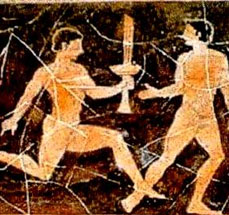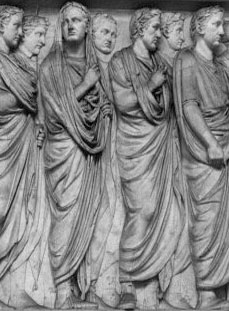
Torch Race
The night before the great procession a relay race with torches was held. Its purpose was to bring fire from the altar of Prometheus/ Eros at the Academy outside the city to the altar of Athena on the Acropolis. Thus, it was an event combining both athletics and ritual. The distance of over 2,500 meters was covered by forty runners, four from each of the ten tribes. Vase paintings frequently show the passing of the torch from one runner to the next. The tricky aspect of this contest was to keep one's torch lit while racing; the comic playwright Aristophanes tells of one inglorious runner breaking wind and thereby extinguishing his torch.

Religious Procession
The final day of the Panathenaic festival was reserved for the main religious events: a grand procession through the city and the sacrifice of 100 oxen to Athena, followed by bountiful feasting. The Panathenaic procession is depicted in considerable detail on the sculpted Ionic frieze that runs above the porches and along the upper walls of the Parthenon. Here we see a splendid cavalcade of horsemen arrayed in their tribal ranks. Ahead of them race the apobates in armor, leaping on and off their speeding chariots, in a magnificent display of equestrian skill. Then come the participants on foot: old men clutching olive branches, musicians with both kitharai and double-pipes, youths bearing water jars and metics shouldering grain baskets for the religious rites, the sacrificial animals led by young herdsmen, and finally, on the east end of the building, young women in the service of Athena carrying libation equipment. The culmination of the Panathenaea is depicted in a unique scene once located above the east door of the Parthenon. Here, in the presence of the Olympian gods, who are seated on either side, the priestess of Athena stands back-to-back with the archon basileus (chief priest); she is receiving stools from two female stool-bearers while he, with the help of a young temple boy, is folding up the peplos that has just been presented to the goddess. According to ancient sources, a scene from the battle of the gods against the Giants was woven into this precious garment.
After the ritual slaughter of the oxen, the meat was distributed to the populace and celebrations and feasting followed. Some critics charged that these great state festivals were put on less for religious reasons than to satisfy the public's craving for meat.
